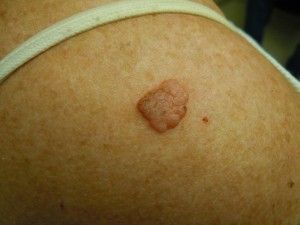- Home
- Editorial
- News
- Practice Guidelines
- Anesthesiology Guidelines
- Cancer Guidelines
- Cardiac Sciences Guidelines
- Critical Care Guidelines
- Dentistry Guidelines
- Dermatology Guidelines
- Diabetes and Endo Guidelines
- Diagnostics Guidelines
- ENT Guidelines
- Featured Practice Guidelines
- Gastroenterology Guidelines
- Geriatrics Guidelines
- Medicine Guidelines
- Nephrology Guidelines
- Neurosciences Guidelines
- Obs and Gynae Guidelines
- Ophthalmology Guidelines
- Orthopaedics Guidelines
- Paediatrics Guidelines
- Psychiatry Guidelines
- Pulmonology Guidelines
- Radiology Guidelines
- Surgery Guidelines
- Urology Guidelines
Topical hydrogen peroxide solution,a less toxic option for Seborrheic keratosis

Seborrheic keratosis is the most common noncancerous skin growth in adults the cause of which is unclear. Currently, the most commonly employed treatment for it is cryosurgery which has a number of post-operative side effects ranging from scarring and blistering to pigment change most notable in dark skin types.A team of researchers at the George Washington University (GW) School of Medicine and Health Sciences compared the toxicological impact of cryosurgery with an FDA-approved topical 40 percent hydrogen peroxide solution (A-101) for the treatment of seborrheic keratosis, in human skin equivalents derived from darker skin types.They have found that topical hydrogen peroxide solution may be less toxic option for patients with noncancerous skin growth The findings were recently published in the Journal of the American Academy of Dermatology.
"Given the common nature of these growths and the frequency with which patients seek treatment for them, we wanted to clearly demonstrate at the cellular level the degree of injury, and most importantly, pigmentary changes, from both the gold standard cryosurgery and a newly approved approach, A-101 topical solution," said Adam Friedman, MD, associate professor of dermatology at the GW School of Medicine and Health Sciences and senior author of the study. "A-101 was found to be less cytotoxic, or toxic to living cells, and less damaging to melanocytes, the cells in the skin that make pigment, than cryosurgery."
In order to predict the toxicological impacts of cryosurgery and the A-101 treatment, the team evaluated skin architecture, metabolic activity, and cytotoxicity, with emphasis on melanocytes. The results of the study show that cryosurgery is a more cytotoxic treatment than A-101 for seborrheic keratosis, which suggests that A-101 could be a safer option for removal of seborrheic keratosis that reduces the risk of post-operative pigment change.
"There is ongoing clinical work evaluating the safety of this solution in darker skin types," said Friedman. "Another important take away from this study is to also recognize how damaging even a small amount of cryotherapy, a five-second free time, can be to human skin. These findings should be considered when using the broad array of skin diseases for which cryosurgery is warranted.

Disclaimer: This site is primarily intended for healthcare professionals. Any content/information on this website does not replace the advice of medical and/or health professionals and should not be construed as medical/diagnostic advice/endorsement or prescription. Use of this site is subject to our terms of use, privacy policy, advertisement policy. © 2020 Minerva Medical Treatment Pvt Ltd